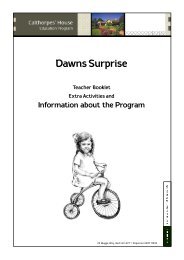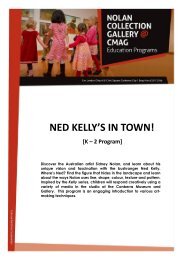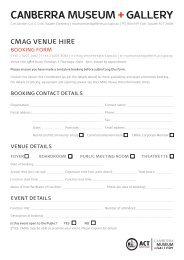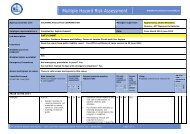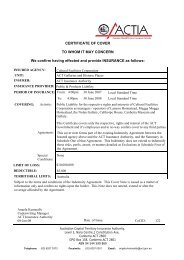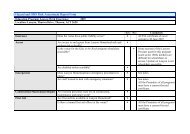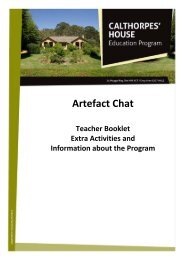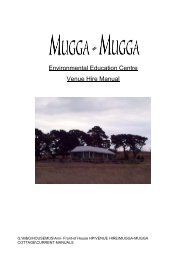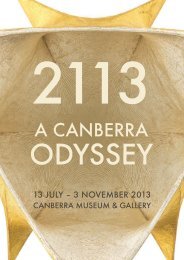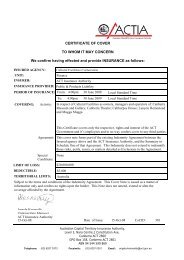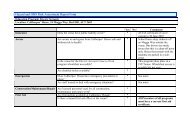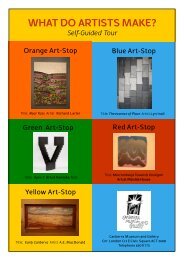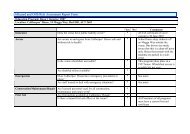Onsite Program Risk Assessment - ACT Museums and Galleries
Onsite Program Risk Assessment - ACT Museums and Galleries
Onsite Program Risk Assessment - ACT Museums and Galleries
You also want an ePaper? Increase the reach of your titles
YUMPU automatically turns print PDFs into web optimized ePapers that Google loves.
Multiple Hazard <strong>Risk</strong> <strong>Assessment</strong>WHSMS Framework Tool B2A3.4tubs on wheels.• Only light weight materialssuch as tarps, smocks, someart supplies, etc, are storedin these tubs.IN THE FOYER/GALLERIESYoung children in galleryspaces<strong>Risk</strong> of:• Damage to collection3 4 H • Presenter demonstrates (<strong>and</strong>reiterates throughout theprogram) appropriate gallerybehaviour including ‘safeh<strong>and</strong>s’ <strong>and</strong> walking bodies,<strong>and</strong> discuss reasons for nottouching the artworks.3 2 M YES• Group managementtechniques such as ‘follow theleader’ when transitioningbetween spaces areemployed.• Presenter always sits betweenchildren <strong>and</strong> artwork/objects.Red <strong>and</strong> White stripey mat<strong>Risk</strong> of:• Tripping3 3 M • Presenter demonstrates (<strong>and</strong>reiterates throughout theprogram) appropriate gallerybehaviour including walkingbodies.3 2 M YES• Children are warned aboutthe tripping on the mat.• Presenters are trained inSenior First Aid <strong>and</strong> a FirstAid Kit is kept in the CMAGStudio <strong>and</strong> at the CMAGFront Desk.Group activities in galleryspacesSlight impact on visitoraccess to gallery spaces –particularly wheelchairaccess<strong>Risk</strong> of trip/fall3 4 H • During artwork/objectinterpretation the Presenterasks children to sit in acontained group to ensure aclear thoroughfare for generalvisitors to the gallery.3 2 M YES• During group activities thePresenter will arrange theCFC Canberra Museum <strong>and</strong> Gallery – Every Picture Tells a Story (onsite) <strong>Risk</strong> <strong>Assessment</strong> B2A3.4 Version 1.0 — 22/02/2012 Page 3 of 7
Multiple Hazard <strong>Risk</strong> <strong>Assessment</strong>WHSMS Framework Tool B2A3.4groups so as to ensure aclear thoroughfare remains.• In the case of a visitor in awheelchair the Presenter willmove groups accordingly.• During group activities thepresenter will ask adults towork with <strong>and</strong> monitor eachgroup.Group activity – sketchingworks with pencils onclipboards<strong>Risk</strong> of:• trip/fall• Marks on gallery walls3 4 H • The presenter will ensure thatall the pencils <strong>and</strong> boards arepacked away before <strong>and</strong> afterthe activity.3 2 M YES• Children are supervised whilethey are using the pencils<strong>and</strong> clipboards <strong>and</strong>appropriate gallery behaviouris reiterated.IN THE STUDIOYoung children running inStudio<strong>Risk</strong> of slip/trip/fallpotentially resulting in:• broken bones• cuts• bruising3 4 H • Before entering the Studiothe Presenter discusses theimportance of not running inthe Studio – <strong>and</strong> reiteratesthis throughout the Studiocomponent (especially beforerotations).3 2 M YES• muscle strain• Children enter the Studio insmall groups.• Adults are asked to place anybags/coats on benches or tothe side.• Presenters are trained inSenior First Aid <strong>and</strong> a FirstAid Kit is kept in the CMAGStudio <strong>and</strong> at the CMAGFront Desk.Easel boards tipping fromchildren leaning on easelshelves.<strong>Risk</strong> of• bruising3 4 H • Children are instructed to siton the floor with their h<strong>and</strong>son their knees until they3 1 M YESCFC Canberra Museum <strong>and</strong> Gallery – Every Picture Tells a Story (onsite) <strong>Risk</strong> <strong>Assessment</strong> B2A3.4 Version 1.0 — 22/02/2012 Page 4 of 7
Multiple Hazard <strong>Risk</strong> <strong>Assessment</strong>WHSMS Framework Tool B2A3.4st<strong>and</strong> up to do their art work.Children falling off green stools<strong>Risk</strong> of slip/fall potentiallyresulting in:• broken bones• cuts• bruising• muscle strain3 4 H • Children are told to sitsquare on the stools, not torock or tip them.• Presenters are trained inSenior First Aid <strong>and</strong> a FirstAid Kit is kept in the CMAGStudio <strong>and</strong> at the CMAGFront Desk.3 2 M YES • Grip pads will be added to thestools.Injury from hard sharp edge ofthe printing press or the rollers<strong>Risk</strong> of injury potentiallyresulting in:• broken bones• cuts• bruising3 3 M • Adults supervise <strong>and</strong> use thepress. The use of the pressis demonstrated by thepresenter.• Children are warned aboutthe sharp edge of the press<strong>and</strong> keeping their fingersaway from the heavy roller.3 2 M YES• Children are required tost<strong>and</strong> behind a line markedon the Studio floor so theyremain at a safe distanceduring the use of the press.• Presenters are trained inSenior First Aid <strong>and</strong> a FirstAid Kit is kept in the CMAGStudio <strong>and</strong> at the CMAGFront Desk.Low sinks<strong>Risk</strong> of• Back <strong>and</strong> musclestrain3 4 H • Plastic tubs which fit betweenthe edges of the sink createa basin at a more appropriatelevel, <strong>and</strong> are used forcleaning dishes <strong>and</strong>equipment.3 3 M YESHot water in tubs for soakingmaterials<strong>Risk</strong> of• Scalding skin3 4 H • Tubs are out of children’sreach.• Adults are told not to puttheir h<strong>and</strong>s in the water.3 2 M YES• Presenters are trained inSenior First Aid <strong>and</strong> a FirstAid Kit is kept in the CMAGStudio <strong>and</strong> at the CMAGCFC Canberra Museum <strong>and</strong> Gallery – Every Picture Tells a Story (onsite) <strong>Risk</strong> <strong>Assessment</strong> B2A3.4 Version 1.0 — 22/02/2012 Page 5 of 7
Multiple Hazard <strong>Risk</strong> <strong>Assessment</strong>WHSMS Framework Tool B2A3.4Front Desk.Hot drinks in the Courtyard<strong>Risk</strong> ofScalding skin3 3 H • Adults are warned about therisk of burns from hot drinks.• Presenters are trained inSenior First Aid <strong>and</strong> a FirstAid Kit is kept in the CMAGStudio <strong>and</strong> at the CMAGFront Desk.3 2 MUnclean h<strong>and</strong>s when returningto preschool<strong>Risk</strong> of• minor food poisoning3 4 H • Children are instructed towash h<strong>and</strong>s in buckets ofsoapy water after leaving theStudio.3 1 M YES• All materials are non toxic.<strong>Risk</strong> rating column key (from <strong>Risk</strong> Matrix, below): C: consequence level, L: likelihood level. <strong>Risk</strong> rating: E = Extreme H = High M = Medium L = LowNote: High <strong>and</strong> extreme risks must be reported to senior management. All risks are to be placed on the WHS <strong>Risk</strong> Register.CFC Canberra Museum <strong>and</strong> Gallery – Every Picture Tells a Story (onsite) <strong>Risk</strong> <strong>Assessment</strong> B2A3.4 Version 1.0 — 22/02/2012 Page 6 of 7
Multiple Hazard <strong>Risk</strong> <strong>Assessment</strong>WHSMS Framework Tool B2A3.4Instructions1. Complete a new line, in the above table, for each identified hazard <strong>and</strong> conduct a risk assessment (RA).2. Use the risk matrix below to risk rate (RR) the level of risk posed by each hazard for the following scenarios, uncontrolled (i.e. the risk the hazard presents without any controls),controlled (i.e. the risk the current controls reduce the risk level to), proposed (i.e. for unacceptable risk, the risk the proposed new control will reduce the risk level to).3. For each scenario, indicate whether the controlled risk is Acceptable/Not acceptable.<strong>Risk</strong> matrixE: Extreme risk — detailed action plan requiredH: High risk — needs senior management attentionM: Medium risk — specify management responsibilityL: Low risk — manage by routine proceduresNote: High or Extreme risks must be reported to seniormanagement <strong>and</strong> require detailed treatment plans toreduce the risk to Low or Medium.PeopleInjuries orailments notrequiring medicaltreatmentMinor injury orfirst aid treatmentcaseConsequencesSerious injurycausinghospitalisation ormultiple medicaltreatment casesLife threateninginjury or multipleserious injuriescausinghospitalisationDeath or multiplelife threateninginjuriesFinancial1% of budget or$5MInsignificant Minor Moderate Major CatastrophicProbability Historical 1 2 3 4 5Likelihood>1 in 10Is expected to occurin mostcircumstances1 in 10–100 Will probably occur 41 in 100–1,000 Might occur at sometime in the future1 in 1,000–10,000Could occur butdoubtful5 Almostcertain32LikelyPossibleUnlikelyM H H E EM M H H EL M M H EL M M H E1 in 10,000–100,000May occur but only inexceptionalcircumstances1RareL L M H ESource: Adapted from AS/NZS 4360: 2004, <strong>Risk</strong> Management <strong>and</strong> Australian Capital Territory Insurance Authority (<strong>ACT</strong>IA) 2004, <strong>Risk</strong> Management Toolkit, <strong>ACT</strong>IA, Canberra, viewed16 June 2009, < http://www.treasury.act.gov.au/actia/<strong>Risk</strong>.htm>.NB: The <strong>Risk</strong> Matrix has been modified to reflect that in the context of health <strong>and</strong> safety any chance, even a rare occurrence, of a death or multiple life threatening injury is consideredextreme.CFC Canberra Museum <strong>and</strong> Gallery – Every Picture Tells a Story (onsite) <strong>Risk</strong> <strong>Assessment</strong> B2A3.4 Version 1.0 — 22/02/2012 Page 7 of 7



